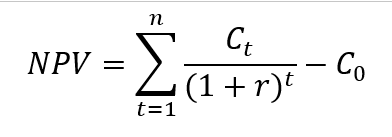When designing a solar power plant project, it is important to consider, the PV modules are calculated how much they will produce, corresponding to the inverter’s AC output power.
With the trend of PV module costs falling and the tariff, the installation of solar systems with higher DC/AC ratios is becoming effective.
The ratio between the installed capacity of the DC part (calculated from the number and capacity of the solar panels) to the installed capacity of the AC part of the inverters is called the DC/AC ratio.
DC/AC =𝑃_(𝐷𝐶 𝑎𝑡 𝑆𝑇𝐶)/𝑃_𝐴𝐶
𝑃_(𝐷𝐶 𝑎𝑡 𝑆𝑇𝐶): Total of DC installation capacity of all PV modules at STC (MW)
𝑃_𝐴𝐶: Total of AC output capacity of all inverters (MW)
Figure 1 below illustrates the inverter AC power output during the day for low and high DC/AC ratios. When a low DC/AC ratio is selected, the output is significantly reduced compared to a high DC/AC ratio. Meanwhile, when choosing a high DC/AC ratio, the output loss is much less and only occurs during the time when the inverter operates over rating threshold.

The financial performance of a project is often assessed through the Net Present Value – NPV
NPV (Net present value) – is the present value of the entire future project cash flow discounted to the present:
NPV = present value of cash outflow (receipts) – present value of cash outflows (spend)

NPV: net present value (M$); t: year of cash outflow; n: lifetime of project; r: discount rate; 𝐶_𝑡: net cash flow at t; 𝐶_0: initial cost of the project.
If NPV is positive the project is efficient.
Normally, the NPV is not only considered an index but is also considered the best method for assessing the profitability of the plan or project because its meaning indicates the net profitability of the project after paying back capital investment and pay all costs (including inflation)
In addition to NPV, the economic analysis of a project is also based on electricity costs (LCOE – Level Cost Of Energy).
LCOE is the net present value of the cost of electricity over the life of a project that generates it. LCOE is calculated by the total lifetime cost divided by the total energy output generated over that time period. Total cost includes initial investment, operating and maintenance costs, fuel costs and capital costs

LCOE: level cost of energy (Cent/kWh); TMDT: Total investment (M$); t: year t; n: lifetime of project (year); 𝐶_𝑡: O&M cost at year t; 𝐴_𝑡: electricity energy at year t (MWh/năm)
LCOE analysis considers costs distributed over the life of the project, providing a highly accurate financial picture. LCOE calculates real cost, measured in Cent/kWh of energy produced.
The lower the LCOE, the lower the cost to produce 1 kWh of electricity energy.
On the basis of the database of solar power projects, the report builds a graph representing the relationship between the ratio DC/AC and NPV, LCOE.


The graph showing the relationship between the DC/AC ratio and NPV, LCOE shows that the optimal DC/AC ratio is 1.5 according to the LCOE criterion and 1.7 according to the NPV criterion.
An inverter can meet optimal DC-AC ratio, the project can reach the best profit threshold
According to ABB and SMA, an inverter that can accommodate DC/AC ratios up to 1.6 to 1.7 is ideal because at that time, the project can reach the best profit threshold to compensate the cost of increasing capacity of DC part, without increasing the fixed cost of the system such as inverter, medium voltage/low voltage power transformer, medium voltage and low voltage switchgear, AC power cable, step up power transformer and transmission line to connect to power system.
However, installing the capacity of the PV module excesses rating of the inverter, increasing the short-circuit current and rated power on the inverter during the process of “cutting” excess power. Inverter must operate at higher intensity for a number of hours, even during the summer months.
With PV module costs falling, incentive pricing policies and new technology, grid-connected features, over-capacity of the PV module will still be a trend to consider in the future.
Factors affecting the DC/AC ratio:
Conclusion: The DC/AC ratio 1.7 is the best economically reported and consistent with the evaluation results of ABB and SMA. However, due to limitations in inverter technology, the report recommends that the DC/AC ratio should be in the range from 1.3 to 1.5. Increasing the DC/AC ratio to its optimal value depends remarkably on inverter technology developments in future.
